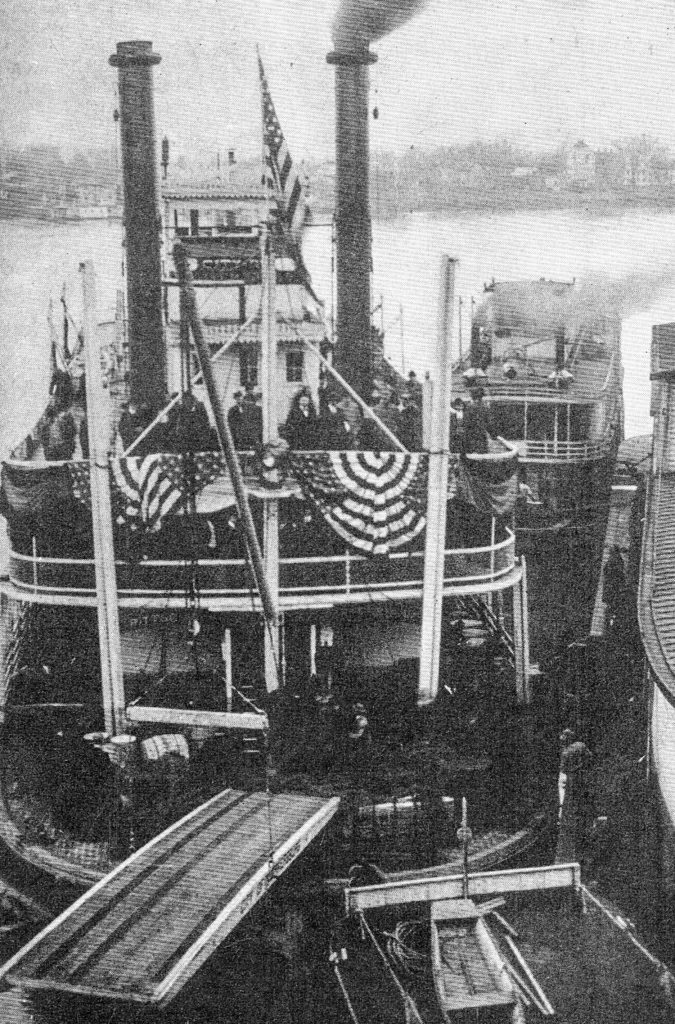The City Of Parkersburg Was A Recycled Riverboat

Built at Harmar, Ohio, in 1899 and originally named Liberty, this sternwheeler was constructed on a wood hull measuring 164 feet in length by 34.4 feet in width. Three boilers provided steam to engines having 17-inch cylinders with a 6-foot stroke.
The steamboat was purchased at Mobile, Ala., in 1912 by John W. Hubbard and, after alterations, renamed City of Parkersburg. Capt. Harry Kraft brought the boat through the Gulf and on to Pittsburgh. The work was done at Dravosburg and included the widening of the guards and repainting of the entire boat.
The renovated vessel came out in early 1913, running in the Pittsburgh–Cincinnati trade for the Ohio & Mississippi Navigation Company. On its second trip, the boat struck a cofferdam at Lock No. 26 and sank; it was quickly raised, repaired, and returned to service.
Low-water conditions forced the boat to lay up from June through November in 1915. Earlier that year, on March 25, the vessel hit an underwater obstruction at Raccoon Island and was towed to Point Pleasant for repairs.
The riverboat later towed the Rice & Dore Floating Water Circus on the Upper Mississippi, reportedly with numerous tribulations. In 1916, the boat was laid up for the entire summer in the Kanawha River at Point Pleasant. In 1917, the sternwheeler ran excursions at Pittsburgh. By early 1918, Capt. J. Orville Noll had entered the vessel in the Pittsburgh–Cincinnati trade. Later that year, during high water conditions, the City of Parkersburg struck a partially sunken barge at Russell, Ky., and sank, a total loss. The boilers were salvaged and installed on the packet Kentucky in 1919.
The Louise
In this week’s image, the City of Parkersburg is shown at the city wharfboat on the occasion of its maiden arrival at the namesake city on January 17, 1913. Seen in the distance (across the river) is the ferryboat Nina Paden.
Alongside the City of Parkersburg is the Kanawha River packet Louise. Built at Parkersburg in 1908 as a gas boat with a hull 103 feet long and 21 feet wide, the little vessel plied the Muskingum River between Zanesville and McConnelsville. Capt. Hiram Douglas, owner of the vessel—which was named for his wife—converted it to steam during the summer of 1911 and ran the boat on the Little Kanawha River in the Parkersburg-Creston trade. In 1919, the packet was in the Zanesville–McConnellsville run, connecting with other boats for Wheeling.
The Louise was sold in July of 1920 to Capt. Joe Chotin of Berwick, La., who moored it at Mound City, Ill., changed the name to Jos. S. Chotin and used it as a towboat. When Chotin built the J.N.
Pharr in 1923, he sold the former Louise to Lorimer Lumber Company, of Jonesville, La., where it was still in operation in 1929.
At the time the image was taken, the flags had just been presented by the Parkersburg Board of Trade. It was later reported by The Waterways Journal that Hubbard thought a grand piano would have made a more suitable gift than several flags!
Editor’s note: For questions or suggestions regarding the Old Boat Column, Keith Norrington may be contacted by e-mail at curatorkeith@yahoo.com, or by mail through the Howard Steamboat Museum at P.O. Box 606, Jeffersonville, Ind. 47131-0606.



